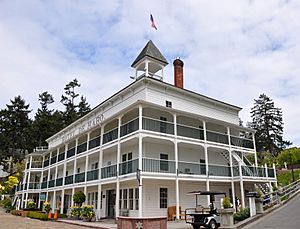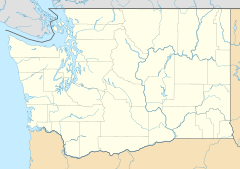Roche Harbor, Washington facts for kids
Quick facts for kids
Roche Harbor
|
|
|---|---|

Hotel de Haro
|
|
| Country | United States |
| State | Washington |
| County | San Juan |
| Population
(2020)
|
|
| • Total | 651 |
| Time zone | UTC-8 (Pacific (PST)) |
| • Summer (DST) | UTC-7 (PDT) |
| ZIP code |
98250
|
| Area code(s) | 360 |
|
Roche Harbor
|
|
| Lua error in Module:Location_map at line 420: attempt to index field 'wikibase' (a nil value). | |
| Location | Northern San Juan Island, San Juan Island, Washington |
| Area | 140 acres (57 ha) |
| Built | 1886 |
| NRHP reference No. | 77001356 |
| Added to NRHP | August 29, 1977 |
Roche Harbor is a safe harbor on the northwest side of San Juan Island in San Juan County, Washington, United States. It is also the name of a popular resort located there. Roche Harbor faces Haro Strait and is close to the border with Canada.
The harbor is well-protected by San Juan Island to the east, Pearl Island to the north, and Henry Island to the west and south. Most of the harbor is about 35 to 45 feet (11 to 14 meters) deep. Roche Harbor also has a small airport mainly used by local people.
Roche Harbor is a special U.S. port of entry. This means boats arriving from other countries can check in here. During summer, agents from Customs and Border Protection are on duty at the marina. If no agents are there, boaters can call them from the Customs Dock.
Contents
History of Roche Harbor
Early History and Native Peoples
Long ago, the area now called Roche Harbor was part of a busy Coast Salish community. It was known as whelaalk, or WH’LEHL-kluh. This community stretched from Roche Harbor to Lonesome Cove. In the mid-1800s, it had 10 large longhouses, which were big homes for many families.
Other nearby Native communities included:
- KWUH-nuhs, meaning “whale,” at Reid Harbor on Stuart Island.
- lhuh-LHEE-ng’kwulh, at Open Bay on Henry Island. This was the home of sweh-TUHN, an important ancestor of the Lummi, Saanich, Samish, and Songhees peoples.
- SMUH-yuh, at what is now Westcott Bay.
- Pe'pi'ow'elh, at what is now called English Camp. People lived here from about 500 AD until 1860. British Marines later tore down a very long house there.
The San Juan Islands are part of the Treaty of Point Elliott from 1855. This treaty made land available for new settlers. However, the First Peoples of the area still have certain rights to resources in their traditional lands, including Roche Harbor. In 2004 and 2008, Coast Salish canoes returned to WH’LEHL-kluh (Roche Harbor) for the annual Canoe Journey. This is a special gathering of Native peoples from the Northwest. In 2016, a ceremony took place at Pe'pi'ow'elh (English Camp). A Reef Net Captain Totem Pole and two Salmon Story Boards were dedicated there.
British Marines came to the area in 1860. This was because Great Britain and the United States both claimed the San Juan Islands. They agreed to share military control until the land dispute was solved. Roche Harbor was named after Lt. Richard Roche. He helped scout the area in the 1840s and 1850s to find a good spot for the British Royal Marines camp.
Lime Company Era: 1850s to 1950s
The British Marines started to quarry and process limestone in Roche Harbor. After the land dispute was settled in 1872, the United States gained control. The land around Roche Harbor was then owned by different people.
In 1886, a lawyer named John S. McMillin and his business partners bought the site. They saw a great chance to expand the limestone business. They started the Tacoma and Roche Harbor Lime Company.
McMillin built the famous Hotel de Haro, where his family lived for many years. He also created a community for his employees. It had cottages, a church, a general store, a post office, a school, and gardens. The McMillin children grew up here. John McMillin loved boating and started the Roche Harbor Yacht Club. The company and the McMillin family often hosted fun events and parties.
The Tacoma and Roche Harbor Lime Company became very important. It had kilns (big ovens for processing lime), a warehouse, a wharf, and many ships. These ships carried lime to growing markets along the West Coast. Lime was used in farming and building, especially after the big 1906 earthquake in San Francisco. Many different people worked and lived in Roche Harbor, including those of British, Coast Salish, Irish, Italian, and Japanese backgrounds.
John McMillin was also active in politics. He wanted to be a U.S. Senator and served on the state Railroad Commission. He also attended important Republican meetings. President Theodore Roosevelt almost visited Roche Harbor in 1903, but his travel schedule did not allow it.
From Lime to Resort: 1950s to Today
In 1956, Paul McMillin, John McMillin's son, sold Roche Harbor. The Reuben J. Tarte family bought it. They turned the town into a boating resort. They restored the Hotel de Haro, built a marina, and added an airstrip where the old farm used to be. They also opened a restaurant in the former McMillin family home.
In 1988, the Tarte family sold Roche Harbor to businessmen Verne Howard and Rich Komen. Today, Roche Harbor is owned by Rich Komen and Saltchuk Resources.
The McMillin family members are buried in a special place nearby called Afterglow Vista. The Hotel de Haro is still a main part of the community. Inside the hotel's store, there is a painting of Louella McMillin, John's wife. It says "MoMo," which was a loving nickname her granddaughters used for her.
Under its current owners, Roche Harbor has grown into a year-round community. New homes have been built in a Craftsman style. There are also new businesses and activities for both residents and visitors. Many historic buildings are still used today, like the hotel, the general store, and the cottages. The old McMillin home is now McMillin's Dining Room. Several of the old lime kilns have been saved. In 2013, the Hotel de Haro was lifted slightly to put a new concrete foundation under it.
Notable People from Roche Harbor
- Wolf Bauer (1912-2016): An engineer at the Tacoma and Roche Harbor Lime Company. He was a conservationist and loved the outdoors. He helped start groups like the Mountain Rescue and Safety Council.
- Hubert L. Cahail (1907-1989): A bus driver and wood splitter for the lime company. He later became the mayor of Friday Harbor from 1942 to 1948.
- Victor J. Capron (1867-1934): The company and community doctor. He started the Island Telephone Co. and was also mayor of Friday Harbor. He served in the state House of Representatives.
- Chester Cayou (1922-2010): A kiln worker at the lime company. He was Saanich from Stuart Island. He fought in World War II. Later, he served for 27 years on the Swinomish Tribe Senate.
- Herbert H. Davis (1867-1929): A ship's captain for the lime company. He was mayor of Friday Harbor from 1923 to 1926.
- John S. McMillin (1855-1936): The president of the Tacoma and Roche Harbor Lime Company. He was a candidate for U.S. Senate in 1895. He also served on the state Railroad Commission.
- Einar Nielsen (1932-1984): The vice president of Roche Harbor Resort. He was a member of the San Juan County Board of County Commissioners.
- William Shultz (1862-1925): The superintendent of the Tacoma and Roche Harbor Lime Company. He was a member of the state House of Representatives.
- Reuben J. Tarte (1901-1968): The president of Roche Harbor Resort. He invented the piggyback flatcar, which helped deliver cars by train. He also donated the land for Reuben Tarte County Park.
- Hugh Campbell Wallace (1864-1931): An early investor in the lime company. He became the U.S. ambassador to France from 1919 to 1921.
Media about Roche Harbor
Books about Roche Harbor
Several books have been written about Roche Harbor or use it as a setting:
- "Roche Harbor: A Saga in the San Juans" by Lynette Evans and George Burley.
- "Cruise of the Calcite" by John A. McCormick. This book tells about a 1908 boat trip on John S. McMillin's yacht, the Calcite.
- "The Roche Harbor Caper" by D.M. Ulmer is a fictional novel set in Roche Harbor.
- "Roche Harbor" by Richard Walker is a history book with pictures.
- "The Building of Roche Harbor Resort by the Tarte Family" by Neil Tarte. This book describes how the Tarte family turned the old lime town into a resort.
Roche Harbor in Film and Television
Roche Harbor was shown in the movie "Namu the Killer Whale." This family drama was filmed in the San Juan Islands in 1966. Clara Tarte, who co-owned Roche Harbor Resort, was also in the movie.
See also
 In Spanish: Roche Harbor (Washington) para niños
In Spanish: Roche Harbor (Washington) para niños



